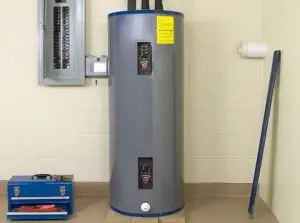Is your hot water heater leaking? Don’t panic. It’s not a particularly dangerous situation but could cause substantial water damage depending on where the water heater is and how long it has been leaking. Unless you’re a plumber yourself, you should get it checked out by a professional.
It is something you should get fixed right away, as damp, wet areas can quickly sprout mold, mildew, or both And according to the EPA, the presence of mold can cause health issues. A leaking water heater could also cause you to need to replace drywall or subfloors.
Keep reading to learn about some of the reasons why your water heater is leaking and what you can do. The information you discover will be helpful when you call the plumber. To fully resolve the issue, you can call Plumbing by Jake at (928) 377-5910, and we will schedule a service call with you that works best for your situation and schedule.
Locate Where the Leak Is
Finding a puddle of water near your water heater can be alarming. But don’t just assume the water is coming from the water heater. Sometimes condensation will form on water pipes and appliances, and that drips down to form the puddle. Condensation is more likely in basements or during damp and rainy weather.
Your washer’s drain line and discharge lines from your water softener could also be the source of the water. It’s time to play detective and figure out where the water is coming from. Take the following steps:
- First, use a towel to mop up any puddles. Then take a good look at the water heater pipes and valves. If there is visible dripping, your water heater is leaking.
- If you don’t see anything obvious, check everything else nearby that uses water. Water always flows to the lowest point, so pay attention to anything above the water heater, or any appliances nearby that are slightly higher.
- If you still don’t see the source of the leak, put a few paper towels under the water heater and maybe one on top. Check the paper towels every so often to see if they have absorbed any water.
- If the paper towels remain dry for a few days, you probably don’t need to worry.
- If the paper towels are damp or soaked and you have eliminated other causes of a leak, your water heater is leaking.
A further examination of your water heater can help you give detailed information to your plumber. Only licensed plumbers should attempt to repair or replace a water heater, especially if gas lines are involved.
Water Heater Leaking from the Top
If the paper towel on top of the water heater got wet, and there is no leak in the ceiling above, there are a couple of possibilities for the source of the leak.
Water Inlet and Outlet Connections
Check the area where the hot and cold water pipes connect to the top of the water heater. If this is the location of the leak, tightening the connections may solve the problem.
Temperature & Pressure Relief Valve
All properly installed hot water heaters have what’s called a temperature & pressure (T&P) relief valve. It’s usually on the side of the tank, but may also be located on the top. The T&P valve is attached to a pipe that runs down the side of the tank to a few inches above the floor. If the only water you saw was right under this pipe, the T&P valve is your issue.
The T&P valve is there for your safety. It will prevent issues if the water inside the tank gets too hot, or so much pressure builds up that the tank is ready to burst. The T&P valve relieves the pressure by releasing some water, which then flows into the pipe and down to the floor. If you have a closed-loop system, you may also have an expansion tank or need one installed.
Only a plumber should replace a faulty T&P valve, or install an expansion tank.
Water Heater Leaking from the Bottom
If you have determined that your water heater is leaking from the bottom, there are a couple of causes for that as well — one more serious than the other.
Drain Valve
Your water heater drain valve is located towards the bottom. Make sure the valve is tightly closed. Also, look at the area where the drain valve goes into the hot water heater tank. It should be a tight seal, with no water or condensation. A drain valve leak can be solved by replacing the valve.
Internal Tank
A hot water heater has an external skin, or a wall that you see, and an internal tank that you don’t see. If the internal tank has a leak, you won’t be able to see it, but you will see water pooling under the bottom of your water heater.
It’s very common for the internal tank to spring a leak when a hot water heater is several years old, or you have extremely hard water. The sediment from hard water can speed up the deterioration of the bottom of the tank. If the internal tank has a leak, the only solution is water heater replacement.
Call Plumbing by Jake for Water Heater Repair and Replacement
If your water heater is leaking, your best course of action is to get it checked out by a local plumber. Call Plumbing by Jake at (928) 377-5910, and we’ll diagnose the issue and let you know your options. In most situations, if your water heater is more than ten years old and is leaking from the bottom, we will recommend replacement. We’ll ask you a few questions about your water usage habits so we can install one that is well suited to you and your family.
If the leak is at the top near the water pipes or one of the valves, we may be able to make a repair.

